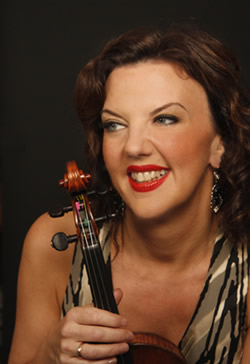The audience that packed Dana Auditorium might have thought it was being exposed to a concert of New Music – for many, it was the first time hearing the four pieces of twentieth-century music magnificently played by the Eastern Music Festival Orchestra, comprised of the best professional musicians from orchestras all across the country. They were decisively led by one of the top American conductors, Maestra JoAnn Falletta, who had led the Young Artists (student) orchestra only two days before. The orchestra is in fine shape after four weeks of rehearsals and performances; ensemble playing was taut, tone was gorgeous, pianissimos spell-binding and fortes powerful and well-balanced.
The concert opened with a clean performance of the increasingly popular “The Chairman Dances: Foxtrot for Orchestra” by John Adams (b. 1947), excerpted from his 1983 opera, Nixon in China. Dr. Falletta situated the work in a short commentary before the performance: Mrs. Mao crashes the dinner party from which she had been banned for political reasons and starts to dance to a recording of a foxtrot (which never really emerges clearly from the orchestra). The work is one of the more successful pieces of minimalist music and one even scornful doubters seem to like.
Erich Wolfgang (!) Korngold’s name is less familiar to audiences than his music, especially to aficionados of old Hollywood films (Adventures of Robin Hood, Sea Hawk, Captain Blood, et al.). Child prodigy and son of a prestigious music critic who evidently admired Mozart, Korngold (1897-1957) was invited to assist Max Reinhardt in a Hollywood adaptation of Mendelssohn’s score to Shakespeare’s Midsummer’s Night Dream, staying thereafter to compose the scores to several films. The score to Robin Hood eventually called him back to Hollywood where he stayed, far from the Nazi onslaught, abandoning an increasingly successful career in Europe as a composer.
His violin concerto occupied him on and off from 1937 until 1945 and was premiered by Jascha Heifetz in 1947. Well known to violinists, on the concert stage it has nonetheless been overshadowed by the concertos of Beethoven, Mendelssohn, Brahms, Tchaikovsky and Sibelius, to say nothing of Bach, Bruch, Mozart or Paganini! It is written in a post-Romantic style, very accessible to audiences and apparently uses themes from several of his movies. [Program notes by Steve Ledbetter.]
Our soloist in the Korngold was British violinist, Tasmin Little, who made international news in 2008 when she pioneered a project entitled “The Naked Violin,” whereby she offered a free download from her website of her new CD of works for unaccompanied (“naked”) violin with introductions and explanations. She has since toured the world in a successful effort to make music and the violin more universally appealing.
And appealing she was in the Korngold! With an opulent, wide but rapid vibrato, perfectly suited to the lush lines of the first movement, and a purity of tone and intonation in the top register of her E-string, she seduced her audience and dazzled it with virtuosity. Marked by passages of descending seconds, resolving downwards in a floating spiral, the second movement revealed Korngold the orchestrator in a lovely nocturnal passage populated by sighing and whispering woodwinds. The third movement is lively and fast, a technical challenge for the violinist and magic to the audience’s ear. A lovely lyrical passage ends with a loud horn call straight from Captain Blood! The instantaneous standing ovation replete with shouts and cheers must have been gratifying to the soloist who rewarded the warm applause with a touching three and four-part version of “Danny Boy.”
Two related works of Italian origin filled the second half of the concert. The first, a little known work by Giuseppe Martucci (1856-1909) for chamber orchestra, Notturno, Op.70/1, was written as a piano piece in 1891 and orchestrated ten years later. It is a lush romantic piece about eight minutes long for strings, reduced winds and a pair of horns. There were some lovely oboe solos (Randall Ellis) and some splendid horn playing (Kevin Reid) as well as the warm dark tones produced by the strings. Naxos has recorded the entire orchestral repertory of Martucci on four CDs.
Ottorino Respighi (1879-1936) studied with Martucci at the turn of the century in Bologna, but another influence, that of Rimsky-Korsakov, with whom Respighi studied in Moscow for five months, was apparent in the final work on this program, Vetrate di chiesa (Church Windows). Three of the four movements are orchestrations of an earlier work for piano, Three Preludes on Gregorian Melodies (1921) and the fourth was composed when the work was orchestrated (1926). The composer and a friend invented descriptive titles for the movements and for the completed suite.
The first movement, “Flight into Egypt” was expressive yet urgent, couched in a 5/4 meter. Clarinet outbursts, brilliantly played by Shannon Scott reminded one of the Rimsky-Korsakov influence. “Michael the Archangel” was as ferocious and loud, yet well balanced, as a fight between angels might be! The “Matins of Saint Clare of Assisi” is the third window, a somber but tender piece in mixed meters which leads into the much longer Finale, “Saint Gregory the Great,” eulogizing the Pope who traveled far and wide standardizing and cataloguing church rituals. A long crescendo, starting ominously over deep organ pedal-point builds to one of the most satisfyingly loud climaxes in all of music, ending with three gongs (sized like Goldilocks’ three bears) adding their simultaneous splash to the loudest fortissimo chords I have ever heard from a symphony orchestra.
Maestra Falletta accepted the tumultuous applause which she shared with the orchestra with equanimity and modesty.











